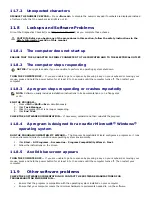
Fill out the Diagnostics Checklist (see "
206H
Diagnostics Checklist") as you complete these checks.
CAUTION:
Before you begin any of the procedures in this section, follow the
207H
Safety Information in this
manual.
NOTE: Connect the modem to an analog telephone jack only. The modem does not operate
while it is connected to a digital telephone network.
CHECK THE MICROSOFT OUTLOOK
®
EXPRESS SECURITY SETTINGS — If you cannot open your e-mail
attachments:
1.
In Outlook Express, click Tools, click Options, and then click Security.
2.
Click Do not allow attachments to remove the checkmark.
CHECK THE TELEPHONE LINE CONNECTION.
CHECK THE TELEPHONE JACK.
CONNECT THE MODEM DIRECTLY TO THE TELEPHONE WALL JACK.
USE A DIFFERENT TELEPHONE LINE —
·
Verify that the telephone line is connected to the jack on the modem. (The jack has either a green label or a
connector-shaped icon next to it.)
·
Ensure that you hear a click when you insert the telephone line connector into the modem.
·
Disconnect the telephone line from the modem and connect it to a telephone. Listen for a dial tone.
·
If you have other telephone devices sharing the line, such as an answering machine, fax machine, surge
protector, or line splitter, then bypass them and connect the modem directly to the telephone wall jack.
If you are using a line that is 3 m (10 ft) or more in length, try a shorter one.
RUN THE MODEM DIAGNOSTIC TOOL — Click the Start button, point to All Programs and then click Modem
Diagnostic Tool. Follow the instructions on the screen to identify and resolve modem problems.
VERIFY THAT THE MODEM IS COMMUNICATING WITH WINDOWS —
1.
Click the Start button and click Control Panel.
2.
Click Printers and Other Hardware.
3.
Click Phone and Modem Options.
4.
Click the Modems tab.
5.
Click the COM port for your modem.
6.
Click Properties, click the Diagnostics tab, and then click Query Modem to verify that the modem is
communicating with Windows.
If all commands receive responses, the modem is operating properly.
ENSURE THAT YOU ARE CONNECTED TO THE INTERNET — Ensure that you have subscribed to an Internet provider.
With the Outlook Express e-mail program open, click File. If Work Offline has a checkmark next to it, click the
checkmark to remove it and connect to the Internet. For help, contact your Internet service provider.
SCAN THE COMPUTER FOR SPYWARE — If you are experiencing slow computer performance, you frequently receive
pop-up advertisements, or you are having problems connecting to the Internet, your computer might be infected with
spyware. Use an anti-virus program that includes anti-spyware protection (your program may require an upgrade) to scan
the computer and remove spyware.
11.5
Error Messages
Fill out the Diagnostics Checklist (see "
208H
Diagnostics Checklist") as you complete these checks.
CAUTION:
Before you begin any of the procedures in this section, follow the safety instructions in the
209H
Safety Information section of this manual.
If the message is not listed, see the documentation for the operating system or the program that was running when the
message appeared.
AUXILIARY DEVICE FAILURE — The touch pad, track stick, or external mouse may be faulty. For an external mouse,
check the cable connection. Enable the Pointing Device option in the system setup program. If the problem persists,
contact Dell Customer Support.
BAD COMMAND OR FILE NAME — Ensure that you have spelled the command correctly, put spaces in the proper place,
and used the correct pathname.






























